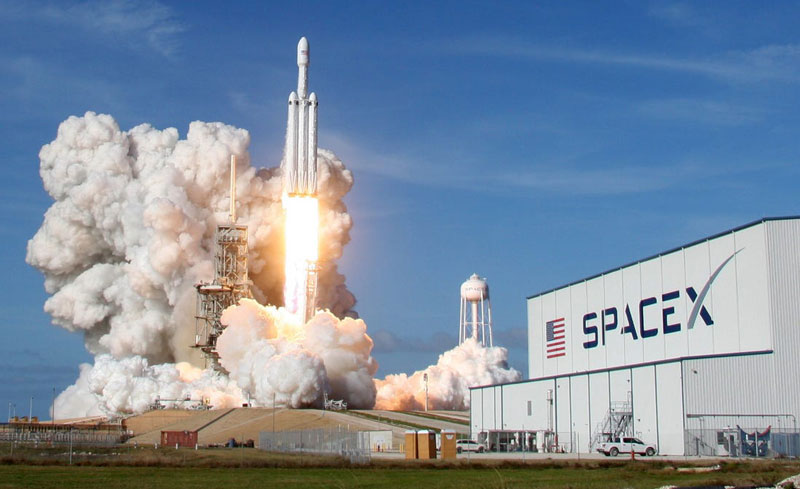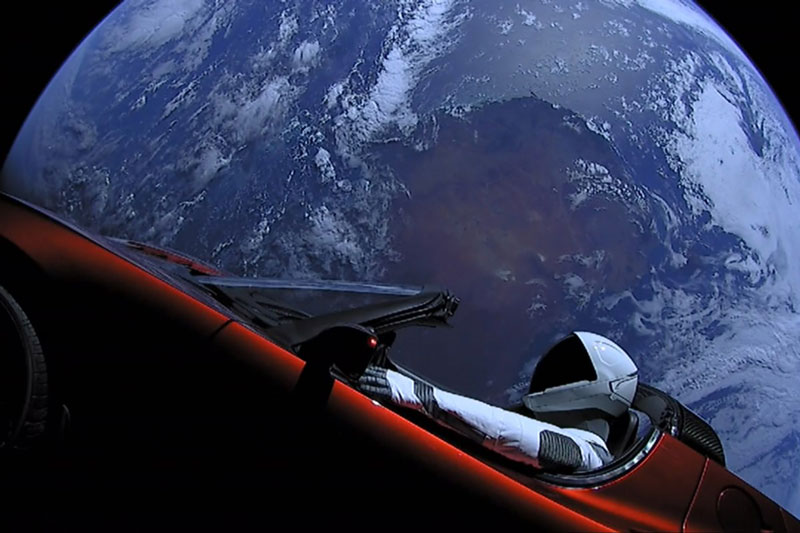The Space X Falcon Heavy Rocket
This powerful rocket is far less well-known than its more famous sibling. The older Falcon 9 is SpaceX’s workhorse: the all-purpose everyday rocket for near Earth missions. This launch vehicle is capable of inserting all kinds of satellites into a variety of Earth circling orbits. It can also be used as a supply ship, ferrying equipment, provisions and the astronauts themselves to the International Space station (ISS).
But for more demanding, long distance and heavy duty purposes such as lunar and even interplanetary missions, something more powerful is required. For these, the company has developed a sturdy alternative – the Falcon Heavy.

The Development of the Falcon Heavy
For all its massively increased power – it is currently the most powerful rocket in the world, the Falcon Heavy uses much the same technology as its smaller sibling. Indeed, it was first conceived before its older brother had even taken flight. The first mention of the concept of this more powerful rocket dates back as far as 2004. References in the media to the prospect of a “Falcon 9 Heavy” appeared the following year.
It was not until 2011 that the prospect of this new Falcon Heavy launcher was finally announced officially. A variety of technical setbacks delayed the final development of this re-design, and Elon Musk himself has admitted that the process was far more complex and difficult than was first envisaged.
The Falcon Heavy design is based on using the same core engines as that used for the Falcon 9. The first stage involves a single central core engine, consisting of a total of nine Merlin 1D engines. Eight are arranged in a hexagonal shape, surrounding a single central engine. In the Falcon Heavy, this main engine is joined by a pair of booster rockets strapped to both sides of the main core. These boosters also consist of the same arrangement of nine Merlin engines. The second stage is a single Merlin 1D engine, modified for use in the near vacuum of space, and is identical to that used on the Falcon 9.
The central unit and the two boosters which constitute the first stage of the rocket are all designed to be re-usable, and are intended to be returned to Earth after use for refurbishment and re-launch on future missions.
Falcon Heavy’s maiden flight came in February 2018. This turned out to be a worldwide media event, as Elon Musk took the opportunity to publicise both his current major technological ventures. His new heavy duty rocket launched a Tesla Roadster convertible into space, with lots of impressive photography of “Starman in space”. The best of these depicted a space suited mannequin appearing to drive the bright red Roadster in orbit, with the blue orb of the Earth as a backdrop.
From a publicity point of view, the flight was a massive success. From a technical point of view, there were a few minor glitches. Whilst both of the first stage boosters returned safely to Earth, the core engine suffered a malfunction on return and crashed into the sea a short distance from the drone ship intended for its landing. Also, the Starman and Roadster overshot its intended orbit, and is expected to end up circling the Sun at approximately the same distance as Mars.
At the time of writing, two further Falcon Heavy flights have taken place. Both have seen successful deployments of their intended satellites and equipment. The third launch in June 2019 saw a variety of payload satellites successfully launched into orbit, including a Deep Space Atomic Clock.
All the booster rockets have been safely returned to Earth. Indeed the boosters used on the second flight were refurbished and re-used for the third. The return of the core first stage engines has been less successful. All have been lost, although the second did make it safely back on board its drone ship before being lost in heavy seas.

Capability of Space X Falcon Heavy
The Falcon Heavy is 70m tall. It consists of two stages and two additional boosters and will constitute a total mass of almost 1.5 million kg (3.1 m lb) at launch. Total thrust produced at lift-off will be over 5 million lb force.
The total payload capability is dependent on the destination of its cargo. It can carry nearly 64,000 kg (around 140,000 lb) to low earth orbit, and just short of 27,000 kg (nearly 59,000 lb) to the much higher geostationary orbit. Greater distances result in a further reduction of potential payload. Approximately 17,000 kg (37,000 lb) would be available for a journey to Mars.
With a total of 27 Merlin D1 engines available to power this impressive rocket skyward, the Falcon Heavy is the most powerful currently available. Its capability is exceeded only by NASA’s iconic Saturn V, used to launch its famous Apollo missions into Earth orbit and indeed the Moon during the 1960s and ‘70s. It last flew in 1973.
In real life use though, it is only for a brief period that all 27 engines are used simultaneously. This only occurs for a few seconds at lift-off. At this point, all engines operate to provide full thrust. After a short period, the central core powers down leaving just the pair of boosters to provide power. When these separate and return to Earth, the core engine is then throttled up to maintain the rocket’s journey skyward until the second stage takes over.
This technique, plus the fact that the Falcon Heavy contains 27 different engines, means that it should be a very reliable launch vehicle. In theory, it could cope with one or even more of its multiple engines failing to operate and yet still successfully complete its mission.
This engine configuration produces more than five million pounds of thrust at launch, equivalent to around eighteen jumbo jets at full power. The amount of payload it can carry is also enormous in comparison with many of its competitors. The 64,000 kg maximum payload is the equivalent of launching a fully loaded Boeing 737, including passengers, crew, luggage and aviation fuel. Again, only the Saturn V could carry more.
The Future of Falcon Heavy
The Falcon Heavy is a relatively new configuration. At the time of writing, its three launches have all been cargo / satellite launching missions. The footage from space of his red Tesla Roadster was a spectacular PR success for Elon Musk, but the two succeeding missions were a practical triumph, successfully launching a variety of satellites into orbit. All currently timetabled future launches are also satellite missions
It is worth noting that this rocket can also carry the Dragon capsule, including the Crew Dragon. This means that it certainly has the capacity to transport astronauts and tourists into space. And with its superior power and payload capacity, it could theoretically carry humans beyond Earth orbit: a visit to the Moon is well within its capability.
The truth is though, that SpaceX is already working on its successor. The Big Falcon Rocket (BFR) is on the drawing board, and the new Starship is intended to supersede the Crew Dragon too.
SpaceX has already announced that it intends to carry its first commercial passenger to the Moon in 2013, when Japanese billionaire Yusaku Maezawa is due to make the trip. This is intended to be on new the BFR / Starship combination, not Falcon Heavy or Crew Dragon.
Indeed, this new rocket is intended to replace all the others in the SpaceX arsenal, so both the Falcon 9 and Falcon Heavy are already due for retirement relatively soon.
So it seems that the future for the Falcon Heavy is a little short. It almost seems as if it is a bit of a stop gap. It will be used to ferry heavy loads into space, and maybe send spacecraft on longer distance missions where something a bit meatier than the Falcon 9 is required. But if things go according to plan, Falcon Heavy’s days are numbered. Only until the Big Falcon Rocket is fully tested and available to take over is it likely to see active service.
